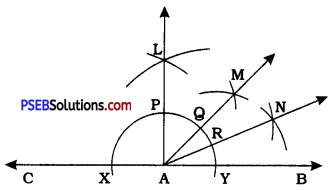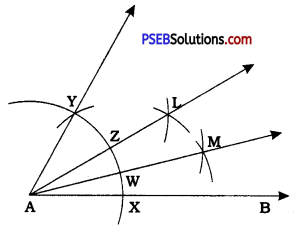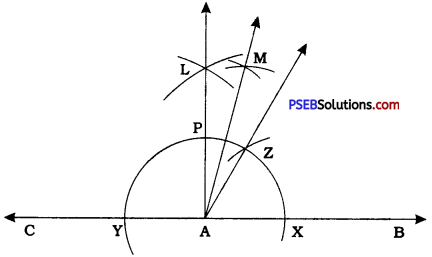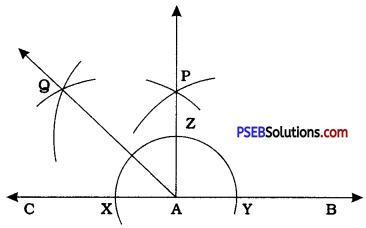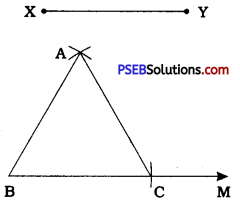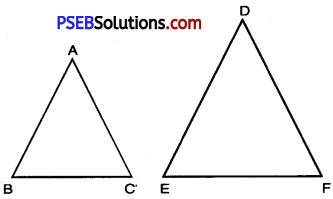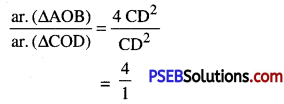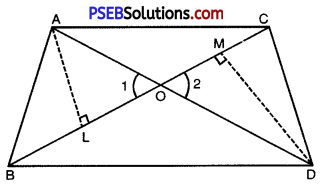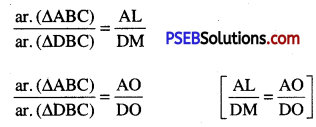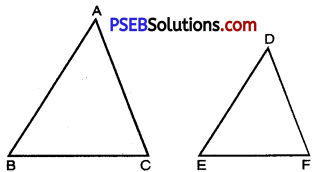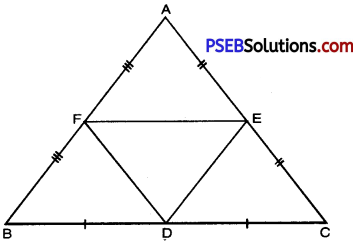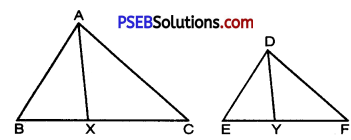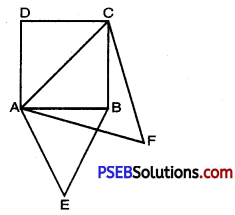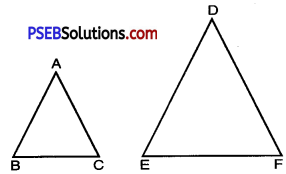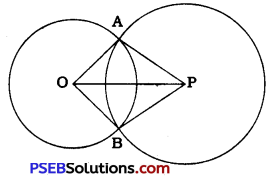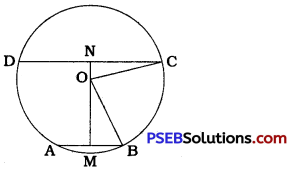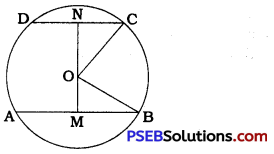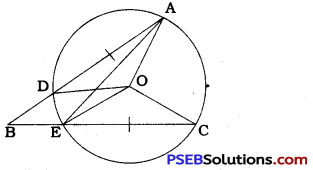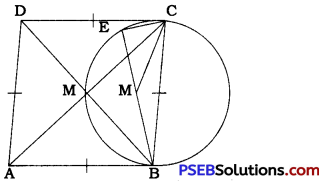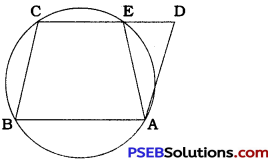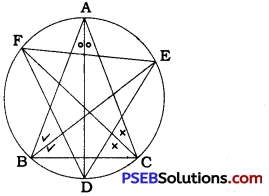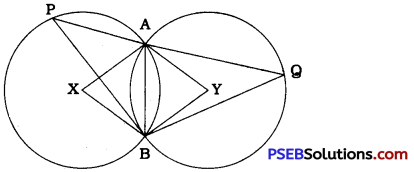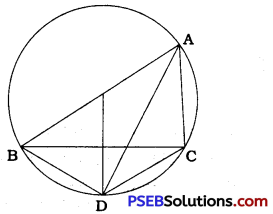Punjab State Board PSEB 10th Class Maths Book Solutions Chapter 6 Triangles Ex 6.3 Textbook Exercise Questions and Answers.
PSEB Solutions for Class 10 Maths Chapter 6 Triangles Ex 6.3
Question 1.
State which pairs of triangles in Fig. are similar. Write the similarity criterion used by you for answering the queStion and also write the pairs of similar triangles in the symbolic form:
(i) 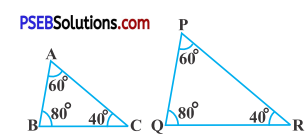
(ii) 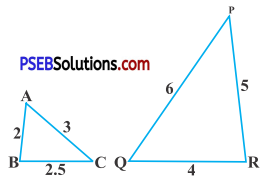
(iii) 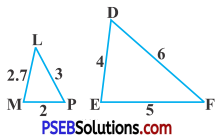
(iv) 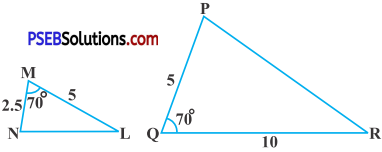
(v) 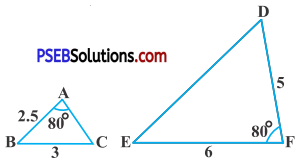
(vi) 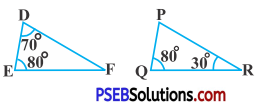

Solution:
(i) In ∆ABC and ∆PQR,
∠A = ∠P (each 60°)
∠B = ∠Q (each 80°)
∠C = ∠R (each 40°)
∴ ∆ABC ~ PQR [AAA Similarity criterion]
(ii) In ∆ABC and ∆PQR,
\(\frac{\mathrm{AB}}{\mathrm{RQ}}=\frac{2}{4}=\frac{1}{2}\) …………….(1)
\(\frac{\mathrm{AC}}{\mathrm{PQ}}=\frac{3}{6}=\frac{1}{2}\) ……………..(2)
\(\frac{\mathrm{BC}}{\mathrm{PR}}=\frac{2.5}{5}=\frac{1}{2}\) ……………(3)
From (1), (2) and (3),
\(\frac{\mathrm{AB}}{\mathrm{RQ}}=\frac{\mathrm{AC}}{\mathrm{PQ}}=\frac{\mathrm{BC}}{\mathrm{PR}}=\frac{1}{2}\)
∴ ΔABC ~ ΔQRP [By SSS similarity criterion]
(iii) In ΔLMP and ΔDEF,
\(\frac{\mathrm{MP}}{\mathrm{DE}}=\frac{2}{4}=\frac{1}{2}\)
\(\frac{\mathrm{PL}}{\mathrm{DF}}=\frac{3}{6}=\frac{1}{2}\)
\(\frac{\mathrm{LM}}{\mathrm{EF}}=\frac{2.7}{5}=\frac{27}{50}\)
\(\)
∴ Two Triangles are not similar.

(iv) In ΔMNL and ΔPQR,
\(\frac{\mathrm{ML}}{\mathrm{QR}}=\frac{5}{10}=\frac{1}{2}\)
∠M = ∠Q (each 70°)
\(\frac{\mathrm{MN}}{\mathrm{PQ}}=\frac{2.5}{5}=\frac{1}{2}\)
∴ ΔMNL ~ ΔPQR [By SAS similarity cirterion]
(v) In ΔABC and ΔDEF,
\(\frac{\mathrm{AB}}{\mathrm{DF}}=\frac{2.5}{5}=\frac{1}{2}\)
\(\frac{\mathrm{BC}}{\mathrm{EF}}=\frac{3}{6}=\frac{1}{2}\)
But ∠B ≠ ∠F
∴ ΔABC and ΔDEF are not similar.
(vi) In ΔDEF, ∠D = 70°, ∠E = 80°
∠D + ∠E + ∠F = 180°
70° + 80° + ∠F = 180° [Angle Sum Propertyl
∠F= 180° – 70° – 80°
∠F = 30°
In ΔPQR,
∠Q = 80°, ∠R = 30°
∠P + ∠Q + ∠R = 180°
(Sum of angles of triangle)
∠P + 80° + 30° = 180°
∠P = 180° – 80° – 30°
∠P = 70°
In ΔDEF and ΔPQR,
∠D = ∠P (70° each)
∠E = ∠Q (80° each)
∠F = ∠R (30° each)
∴ ΔDEF ~ ΔPQR (AAA similarity criterion).

Question 2.
In Fig., ΔODC ~ ΔOBA, ∠BOC = 125° and ∠CDO = 70°. FInd ∠DOC, ∠DCO and ∠OAB.
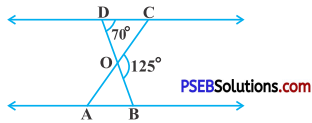
Solution:
Given that: ∠BOC = 125°
∠CDO = 70°
DOB is a straight line
∴ ∠DOC + ∠COB = 180°
[Linear pair Axiom]
∠DOC + 125° = 180°
∠DOC = 180°- 125°
∠DOC = 55°
∠DOC = ∠AOB = 55°
[Vertically opposite angle]
But ΔODC ~ ΔOBA
∠D = ∠B = 70°
In ΔDOC, ∠D + ∠O + ∠C = 180°
70° + 55° + ∠C = 180°
∠C= 180° – 70° – 55°
∠C = 55°
∠C = ∠A = 55°
Hence ∠DOC = 55°
∠DCO = 55°
∴ ∠OAB = 55°.

Question 3.
Diagonals AC and BD of a trapezium ABCD with AB || DC intersect each other at the point O. Using a similarity criterion for two triangles, show that \(\frac{\mathbf{O A}}{\mathbf{O C}}=\frac{\mathbf{O B}}{\mathbf{O D}}\).
Solution:
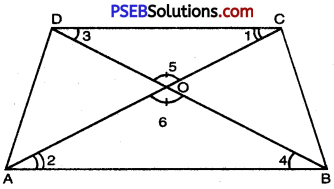
Given: In Trapezium ABCD, AB || CD, and diagonal AC and BD intersects each other at O.
To Prove = \(\frac{\mathrm{OA}}{\mathrm{OC}}=\frac{\mathrm{OB}}{\mathrm{OD}}\) (Given)
Proof: AB || DC (Given)
In ΔDOC and ΔBOA,
∠1 = ∠2 (alternate angle)
∠5 = ∠6 (vertical opposite angle)
∠3 = ∠4 (alternate angle)
∴ ΔDOC ~ ΔBOA [AAA similarity criterion]
∴ \(\frac{\mathrm{DO}}{\mathrm{BO}}=\frac{\mathrm{OC}}{\mathrm{OA}}\)
[If two triangle are similar corresponding sides are Proportional }
⇒ \(\frac{\mathrm{OA}}{\mathrm{OC}}=\frac{\mathrm{BO}}{\mathrm{DO}}\)
Hence Proved.

Question 4.
In Fig., \(\) and ∠1 = ∠2. Show that ∆PQS ~ ∆TQR.
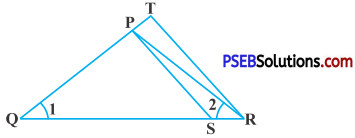
Solution:
Given that,
\(\frac{\mathrm{QR}}{\mathrm{QS}}=\frac{\mathrm{QT}}{\mathrm{PR}}\) and
∠1 = ∠2
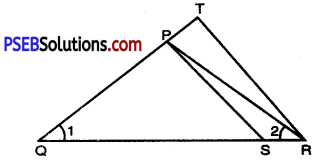
To Prove. PQS – ITQR
Proof: In ΔPQR,
∠1 = ∠2 (given)
∴ PR = PQ
[Equal angle have equal side opposite to it]
and = \(\frac{\mathrm{QR}}{\mathrm{QS}}=\frac{\mathrm{QT}}{\mathrm{PR}}\) (given)
or \(\frac{\mathrm{QR}}{\mathrm{QS}}=\frac{\mathrm{QT}}{\mathrm{PQ}}\) [PR = PQ]
⇒ \(\frac{\mathrm{QS}}{\mathrm{QR}}=\frac{\mathrm{PQ}}{\mathrm{QT}}\)
In ΔPQS and ΔTQR,
\(\frac{\mathrm{QS}}{\mathrm{QR}}=\frac{\mathrm{PQ}}{\mathrm{QT}}\)
∠1 = ∠1 (common)
∴ ∆PQS ~ ∆TQR [SAS similarity criterion]
Hence proved.

Question 5.
S and T are points on skies PR and QR of ∆PQR such that ∠P = ∠RTS. Show that ∆RPQ ~ ∆RTS.
Solution:
S and T are the points on side PR and QR such that ∠P = ∠RTS.
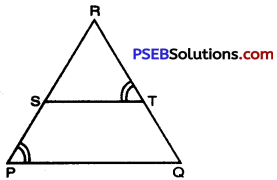
To Prove. ∆RPQ ~ ∆RTS
Proof: In ∆RPQ and ∆RTS
∠RPQ = ∠RTS (given)
∠R = ∠R [common angle]
∴ RPQ ~ ARTS
[By AA similarity critierion which is the required result.]
Question 6.
In figure ∆ABE ≅ ∆ACD show that ∆ADE ~ ∆ABC.

Solution:
Given. ∆ABC in which ∆ABE ≅ ∆ACD
To Prove. ∆ADE ~ ∆ABC
Proof. ∆ABE ≅ ∆ACD (given)
AB = AC (cpct) and AE = AD (cpct)
\(\frac{A B}{A C}=1\) ……………..(1)
\(\frac{A E}{A D}=1\) …………….(2)
From (1) and (2).
\(\frac{\mathrm{AB}}{\mathrm{AC}}=\frac{\mathrm{AD}}{\mathrm{AE}}\)
In ∆ADE and ∆ABC,
\(\frac{\mathrm{AD}}{\mathrm{AE}}=\frac{\mathrm{AB}}{\mathrm{AC}}\)
∠A = ∠A (common)
∴ ∆ADE ~ ∆ABC [By SAS similarity criterion].

Question 7.
In Fig., altitudes AD and CE of ∆ABC intersect each other at the point P.
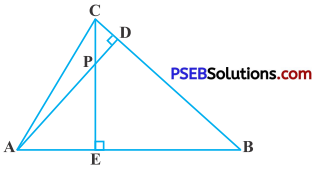
Show that:
(i) ∆AEP ~ ∆CDP
(ii) ∆ABD ~ ∆CBE
(iii) ∆AEP ~ ∆ADB
(iv) ∆PDC ~ ∆BEC
Solution:
Given. ∆ABC, AD ⊥ BC CE⊥AB,
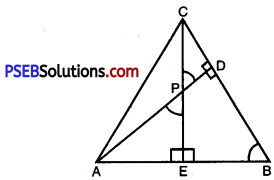
To Prove. (i) ∆AEP ~ ∆CDP
(ii) ∆ABD ~ ∆CBE
(iii) ∆AEP ~ ∆ADB
(iv) ∆PDC ~ ∆BEC
Proof:
(i) In ∆AEP and ∆CDP,
∠E = ∠D (each 90°)
∠APE = ∠CPD (vertically opposite angle)
∴ ∆AEP ~ ∆CDP [By AA similarity criterion].
(ii) In ∆ABD and ∆CBE,
∠D = ∠E (each 90°)
∠B = ∠B (common)
∴ ∆ABD ~ ∆CBE [AA Similarity criterion]
(iii) In ∆AEP and ∆ADB.
∠E = ∠D (each 90°)
∠A = ∠A (common)
∴ ∆AEP ~ ∆ADB [AA similarity criterion].
(vi) In ∆PDC and ∆BEC,
∠C = ∠C
∠D = ∠E
∴ ∆SPDC ~ ∆BEC [AA similarity criterion].

Question 8.
E is a point on the side AD produced of a parallelogram ABCD and BE Intersects CD at F. Show that AABE – &CFB.
Solution:
Given. Parallelogram ABCD. Side AD is produced to E, BE intersects DC at F.
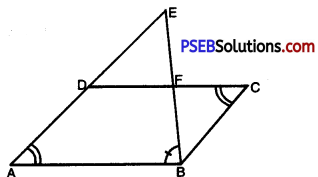
To Prove. ∆ABE ~ ∆CFB
Proof. In ∆ABE and ∆CFB.
∠A = ∠C (opposite angle of || gm)
∠ABE = ∠CFB (alternate angle)
∴ ∆ABE ~ ∆CFB (AA similarity criterion)
Question 9.
In Fig., ABC and AMP are two right triangles, right angled at B and M respectively. Prove that:
(i) ∆ABC ~ ∆AMP
(ii) \(\frac{\mathbf{C A}}{\mathbf{P A}}=\frac{\mathbf{B C}}{\mathbf{M P}}\)
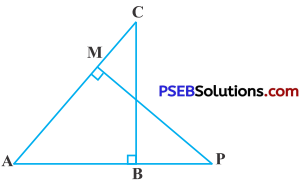
Solution:
Given. ∆ABC and ∆AMP are two right triangles right angled at B and M.
To Prove. (i) ∆ABC ~ ∆AMP
(ii) \(\frac{\mathbf{C A}}{\mathbf{P A}}=\frac{\mathbf{B C}}{\mathbf{M P}}\)
Proof. In ∆ABC and ∆AMP,
∠A = ∠A (common)
∠B = ∠M (each 90°)
(i) ∴ ∆ABC ~ ∆AMP (AA similarity criterion)
(ii) ∴ \(\frac{\mathrm{AC}}{\mathrm{AP}}=\frac{\mathrm{BC}}{\mathrm{MP}}\)
[If two triangles are similar corresponding sides]
\(\frac{\mathrm{CA}}{\mathrm{PA}}=\frac{\mathrm{BC}}{\mathrm{MP}}\)
Hence Proved.

Q. 10.
CD and GH are respectively the vectors of ∠ACB and ∠EGF such that D and H lie on sides AB and FE of ∆ABC and
∆EFG respectively. If ∆ABC ~ ∆FEG, show
(i) \(\frac{\mathbf{C D}}{\mathbf{G H}}=\frac{\mathbf{A C}}{\mathbf{F G}}\)
(ii) ∆DCB ~ ∆HGE
(iii) ∆DCA ~ ∆HGF
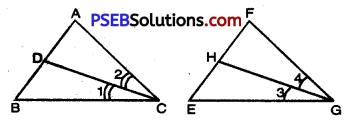
Given. In ∆ABC and ∆EFG, CD and OH are bisector of ∠ACB and ∠EGF
i.e. ∠1 = ∠2
and ∠3 = ∠4
and ∆ABC ~ ∆FEG
To Prove. (i) = \(\frac{\mathbf{C D}}{\mathbf{G H}}=\frac{\mathbf{A C}}{\mathbf{F G}}\)
(ii) ∆DCB ~ ∆HGE
(iii) ∆DCA ~ ∆HGF
Proof.
(i) Given that, ∆ABC ~ ∆FEG
∴ ∠A = ∠F; ∠B = ∠E
and ∠C = ∠C
[∵ The corresponding angles of similar triangles are equal]
Consider, ∠C = ∠C [Proved above]
\(\frac{1}{2}\) ∠C = \(\frac{1}{2}\) ∠G
∠2 = ∠4 or ∠1 = ∠3
Now, in ∆ACD and ∆FGH
∠A = ∠F [Proved above]
∠2 = ∠4 [Proved above]
∴ ∠ACD ~ ∠FGH [∵ AA similarity creterion]
Also, \(\frac{\mathrm{CD}}{\mathrm{GH}}=\frac{\mathrm{AC}}{\mathrm{FG}}\)
[∵ Corresponding sides are in proportion].
(ii) In ∆DCB and ∆HGE,
∠B = ∠E [Proved above]
∠1 = ∠3 [Proved above]
∴ ∆DCB ~ ∆HGE [∵ AA similarity criterion]
(iii) In ∆DCA and ∆HGF
∠A = ∠F [Proved above]
∠2 = ∠4 [Proved above]
∴ ∆DCA ~ ∆HGF [∵ AA similarity criterion].

Question 11.
In Fig., E is a point on side CB produced of an Isosceles triangle ABC with AB = AC. IfAD ⊥BC and EF ⊥ AC, prove that ∆ABD ~ ∆ECF.
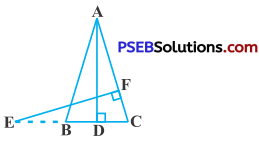
Solution:
Given. ∆ABC, isosceles triangle with AB = AC AD ⊥ BC, side BC is produced to E. EF ⊥ AC
To Prove. ∆ABD ~ ∆ECF
Proof. ∆ABC is isosceles (given)
AB = AC
∴ ∠B = ∠C [Equal sides have equal angles opposite to it)
In ∆ABD and ∆ECF,
∠ABD = ∠ECF (Proved above)
∠ADB = ∠EFC (each 90°)
∴ ∠ABD – ∠ECF [AA similarity).
Question 12.
Sides AB and BC and median AD of a triangle ABC are respectively proportional to sides PQ and QR and median PM of ∆PQR (see Fig.). Show that ∆ABC ~ ∆PQR.

Solution:
Given. ∆ABC and ∆PQR, AB, BC, and median AD of ∆ABC are proportional to side PQ; QR and median PM of ∆PQR,
i.e., \(\frac{\mathrm{AB}}{\mathrm{PQ}}=\frac{\mathrm{AC}}{\mathrm{PR}}=\frac{\mathrm{AD}}{\mathrm{PM}}\)
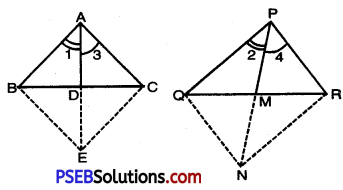
To prove: ∆ABC ~ ∆PQR
Construction: Produce AD to E such that AD = DE and Produce PM to N such that PM = MN join BE, CE, QN and RN
Proof: \(\frac{\mathrm{AB}}{\mathrm{PQ}}=\frac{\mathrm{AC}}{\mathrm{PR}}=\frac{\mathrm{AD}}{\mathrm{PM}}\) (given) …………..(1)
BD = DC (given)
AD = DE (construction)
Diagonal bisects each other ¡n quadrilateral ABEC
∴ Quadrilateral ABEC is parallelogram
Similarly PQNR is a parallelogram
∴ BE = AC (opposite sides of parallelogram) and QN = PR
\(\frac{\mathrm{BE}}{\mathrm{AC}}=1\) ……………(i)
\(\frac{\mathrm{QN}}{\mathrm{PR}}=1\) …………..(ii)
From (i) and (ii),
\(\frac{\mathrm{BE}}{\mathrm{AC}}=\frac{\mathrm{QN}}{\mathrm{PR}}\)
⇒ \(\frac{\mathrm{BE}}{\mathrm{QN}}=\frac{\mathrm{AC}}{\mathrm{PR}}\)
But \(\frac{A B}{P Q}=\frac{A C}{P R}\) (Given)
∴ \(\frac{B E}{Q N}=\frac{A B}{P Q}\) …………..(2)
\(\frac{\mathrm{AB}}{\mathrm{PQ}}=\frac{\mathrm{AD}}{\mathrm{PM}}\) From (1)
= \(\frac{2 \mathrm{AD}}{2 \mathrm{PM}}\)
\(\frac{\mathrm{AB}}{\mathrm{PQ}}=\frac{\mathrm{AE}}{\mathrm{PN}}\) …………..(3)
From (2) and (3),
\(\frac{\mathrm{AB}}{\mathrm{PQ}}=\frac{\mathrm{BE}}{\mathrm{QN}}=\frac{\mathrm{AE}}{\mathrm{PN}}\)
∴ ∆ABE ~ ∆PQN [Sides are Proportional]
∴ ∠1 = ∠2 …………….(4) [Corresponding angle of similar triangle]
|| ly ∆ACE ~ ∆PRN ……….(5) [Corresponding angle of similar triangle]
Adding (4) and (5).
∠1 + ∠3 = ∠2 + ∠4
∠A = ∠P
Now in ∆ABC and ∆PQR,
∠A = ∠P (Proved)
\(\frac{\mathrm{AB}}{\mathrm{PQ}}=\frac{\mathrm{AC}}{\mathrm{PR}}\) (given)
∴ ∆ABC ~ ∆PQR [By using SA similarity criterion]
Hence Proved.

Question 13.
D is a point on the side BC of a triangle ABC such that ∠ADC = ∠BAC. Show that CA2 = CB. CD.
Solution:
Given. ∆ABC, D is a point on side BC such that ∠ADC = ∠BAC
To Prove. CA2 = BC × CD
Proof. In ABC and ADC,
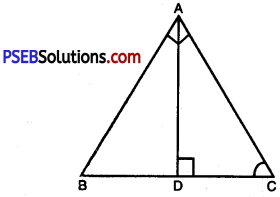
∠C = ∠C (common)
∠BAC = ∠ADC (given)
∴ ∆ABC ~ ∆DAC [by AA similarity criterion]
∴ \(\frac{\mathrm{AC}}{\mathrm{DC}}=\frac{\mathrm{BC}}{\mathrm{AC}}\)
[If two triangles are similar corresponding sides are proportional]
AC2 = BC. DC Hence Proved.
Question 14.
Sides AB and AC and median AD of a triangle ABC are proportional to sides PQ and PR and median PM of another
triangle PQR. Prove that ∆ABC ~ ∆PQR.
Solution:
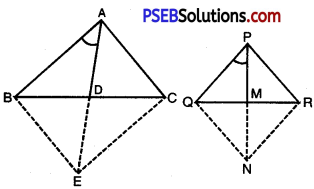
Given: Two ∆s ABC and PQR. D is the mid-point of BC and M is the mid-point of QR. and \(\frac{\mathrm{AB}}{\mathrm{PQ}}=\frac{\mathrm{AC}}{\mathrm{PR}}=\frac{\mathrm{AD}}{\mathrm{PM}}\) ………..(1)
To Prove: ∆ABC ~ ∆PQR
Construction:
Produce AD to E such that AD = DE
Join BE and CE.
Proof. In quad. ABEC, diagonals AE and
BC bisect each other at D.
∴ Quad. ABEC is a parallelogram.
Similarly it can be shown that quad PQNR is a parallelogram.
Since ABEC is a parallelogram
∴. BE = AC ………….(2)
Similarly since PQNR is a || gm
∴ QN = PR ………….(3)
Dividing (2) by (3), we get:
\(\frac{B E}{Q N}=\frac{A C}{P R}\) …………….(4)
Now \(\frac{\mathrm{AD}}{\mathrm{PM}}=\frac{2 \mathrm{AD}}{2 \mathrm{PM}}=\frac{\mathrm{AE}}{\mathrm{PN}}\)
∴ ∠BAE = ∠QPN ………….(5)
From (1), (4) and (5), we get:
\(\frac{A D}{P Q}=\frac{B E}{Q N}=\frac{A E}{P N}\)
Thus in ∆s ABE and PQN, we get:
\(\frac{\mathrm{AB}}{\mathrm{PQ}}=\frac{\mathrm{BE}}{\mathrm{QN}}=\frac{\mathrm{AE}}{\mathrm{PN}}\)
∴ ∆ABC ~ ∆PQN
∴ ∠BAE = ∠QPN ………..(6)
Similarly it can be proved that
∆AEC ~ ∆PNR
∴ ∠EAC = ∠NPR …………..(7)
Adding (6) and (7), we get:
∠BAE + ∠EAC = ∠QPN + ∠NPR
i.e., ∠BAC = ∠QPR
Now in ∆ABC and ∆PQR.
\(\frac{A B}{P Q}=\frac{A C}{P R}\)
and included ∠A = ∠P
∴ ∆ABC ~ ∆QPR (By SAS criterion of similarity).

Question 15.
A vertical pole of length 6 m casts a shadow 4 m long on the ground and at the same time a tower casts a shadow 28 m long. Find the height of the tower.
Solution:
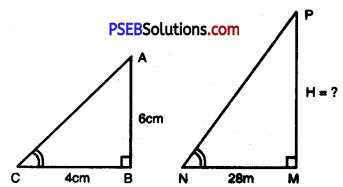
Length of vertical stick = 6 m
Shadow of stick = 4 m
Let height of tower be H m
Length of shadow of tower = 28 m
In ∆ABC and ∆PMN,
∠C = ∠N (angle of altitude of sun)
∠B = ∠M (each 90°)
∴ ∆ABC ~ ∆PMN [AA similarity criterion]
∴ \(\frac{\mathrm{AB}}{\mathrm{PM}}=\frac{\mathrm{BC}}{\mathrm{MN}}\)
[If two triangles are similar corresponding sides are proportional]
∴ \(\frac{6}{\mathrm{H}}=\frac{4}{28}\)
H = \(\frac{6 \times 28}{4}\)
H = 6 × 7
H = 42 m.
Hence, Height of Tower = 42 m.
Question 16.
If AD and PM are medians of triangles ABC and PQR, respectively where ∆ABC ~ ∆PQR, prove that \(\frac{\mathbf{A B}}{\mathbf{P Q}}=\frac{\mathbf{A D}}{\mathbf{P M}}\).
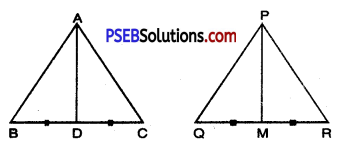
Solution:
Given: ∆ABC and ∆PQR, AD and PM are median and ∆ABC ~ ∆PQR
To Prove: \(\frac{\mathrm{AB}}{\mathrm{PQ}}=\frac{\mathrm{AD}}{\mathrm{PM}}\)
Proof. ∆ABC ~ ∆PQR (given)
∴ \(\frac{A B}{P Q}=\frac{B C}{Q R}=\frac{A C}{P R}\)
(If two triangles are similar corrosponding sides are Proportional)
∠A = ∠P
(If two triangles are similar corrosponding angles are equal)
∠B = ∠Q
∠C = ∠R
D is mid Point of BC
∴ BD = DC = \(\frac{1}{2}\) BC ……………..(2)
M is mid point of OR
∴ QM = MR = \(\frac{1}{2}\) QR …………….(3)
\(\frac{A B}{P Q}=\frac{B C}{Q R}\)
\(\frac{\mathrm{AB}}{\mathrm{PQ}}=\frac{2 \mathrm{BD}}{2 \mathrm{QM}}\) (from(2)and(3))
\(\frac{A B}{P Q}=\frac{B D}{Q M}\)
∠ABD = ∠PQM (given)
∆ABC ~ ∆PQM (By SAS similarity criterion)
\(\frac{\mathrm{AB}}{\mathrm{PQ}}=\frac{\mathrm{AD}}{\mathrm{PM}}\)
[If two triangles are similar corresponding sides are proportional].

![]()
![]()

![]()

![]()

![]()
![]()
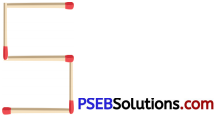

![]()
![]()




























